Sony FF051021 GSM/GPRS 850/900/1800/1900 Module User Manual Exhibit 8
Sony Mobile Communications Inc GSM/GPRS 850/900/1800/1900 Module Exhibit 8
Sony >
Exhibit 8 user manual

Confidential
INTERFACE DESCRIPTION
1(31)
Document number Revision
1/155 19-KRD 104 1025 Uen PA4
EDGE EE5x Interface Specification
The information contained in this document is the proprietary information of Sony Ericsson Mobile
Communications International. The contents are confidential and any disclosure to persons other
than the officers, employees, agents or subcontractors of the owner or licensee of this document,
without the prior written consent of Sony Ericsson Mobile Communications International, is
strictly prohibited. Further, no portion of this publication may be reproduced, stored in a retrieval
system, or transmitted in any form or by any means, electronic or mechanical, including
photocopying and recording, without the prior written consent of Sony Ericsson Mobile
Communications International, the copyright holder.

Confidential
INTERFACE DESCRIPT
2(31)
Document number Revision
1/155 19-KRD 104 1025 Uen PA4
Sony Ericsson Mobile Communications International publishes this document without making any
warranty as to the content contained herein. Further Sony Ericsson Mobile Communications
International reserves the right to make modifications, additions and deletions to this document due to
typographical errors, inaccurate information, or improvements to programs and/or equipment at any time and
without notice. Such changes will, nevertheless be incorporated into new editions of this document.
All rights reserved.
© Sony Ericsson Mobile Communications International, 2005
Revision Information
PA1 Sep 2005 First release

Confidential
INTERFACE DESCRIPT
3(31)
Document number Revision
1/155 19-KRD 104 1025 Uen PA4
Contents
Part 1 : Overview ...............................................................................................4
1 Introduction..........................................................................................5
1.1 Target Users........................................................................................6
1.2 Prerequisites........................................................................................6
1.3 Notation ...............................................................................................6
2 EDGE Wireless Modem.......................................................................7
2.1 EDGE Wireless Modem in a Communication System .........................7
2.2 Functional Block Diagram....................................................................9
2.3 Features ............................................................................................10
2.3.1 Mobile Station Characteristics ...........................................................10
2.3.2 Environmental Conditions..................................................................11
2.4 SIM Card ...........................................................................................11
2.5 Other Features ..................................................................................11
2.6 Precautions........................................................................................11
Part 2 : Daughter Card Description .................................................................12
3 Mechanical Description .....................................................................13
3.1 Physical Detail ...................................................................................13
3.2 Variant Information ............................................................................14
3.2.1 Board Outline.....................................................................................14
3.2.2 System Connector .............................................................................14
4 System Interface................................................................................15
4.1 Overview............................................................................................15
4.1.1 System Connector .............................................................................15
4.2 Electrical Interface Detail Format.......................................................18
5 Electrical Interface .............................................................................19
5.1 Power Interfaces................................................................................19
5.1.1 VIN.....................................................................................................20
5.1.2 3V3 ....................................................................................................21
5.1.3 VREF .................................................................................................21
5.1.4 GND...................................................................................................22
5.2 Status Interfaces................................................................................23
5.2.1 UVP ...................................................................................................23
5.2.2 OVP ...................................................................................................24
5.2.3 RI .......................................................................................................24
5.2.4 LED....................................................................................................25
5.2.5 VREF .................................................................................................25
5.3 Data Communication and Control Interfaces.....................................26
5.3.1 USB Interface ....................................................................................26
5.3.2 P_EN .................................................................................................26
5.4 ANTENNA CONNECTOR .................................................................27
6 Rudimentary Circuit Functions ..........................................................28
6.1 Power On Sequence .........................................................................28
6.2 Power Off Sequence .........................................................................29
6.3 USB communications information .....................................................30

Confidential
INTERFACE DESCRIPT
4(31)
Document number Revision
1/155 19-KRD 104 1025 Uen PA4
Part 1 : Overview
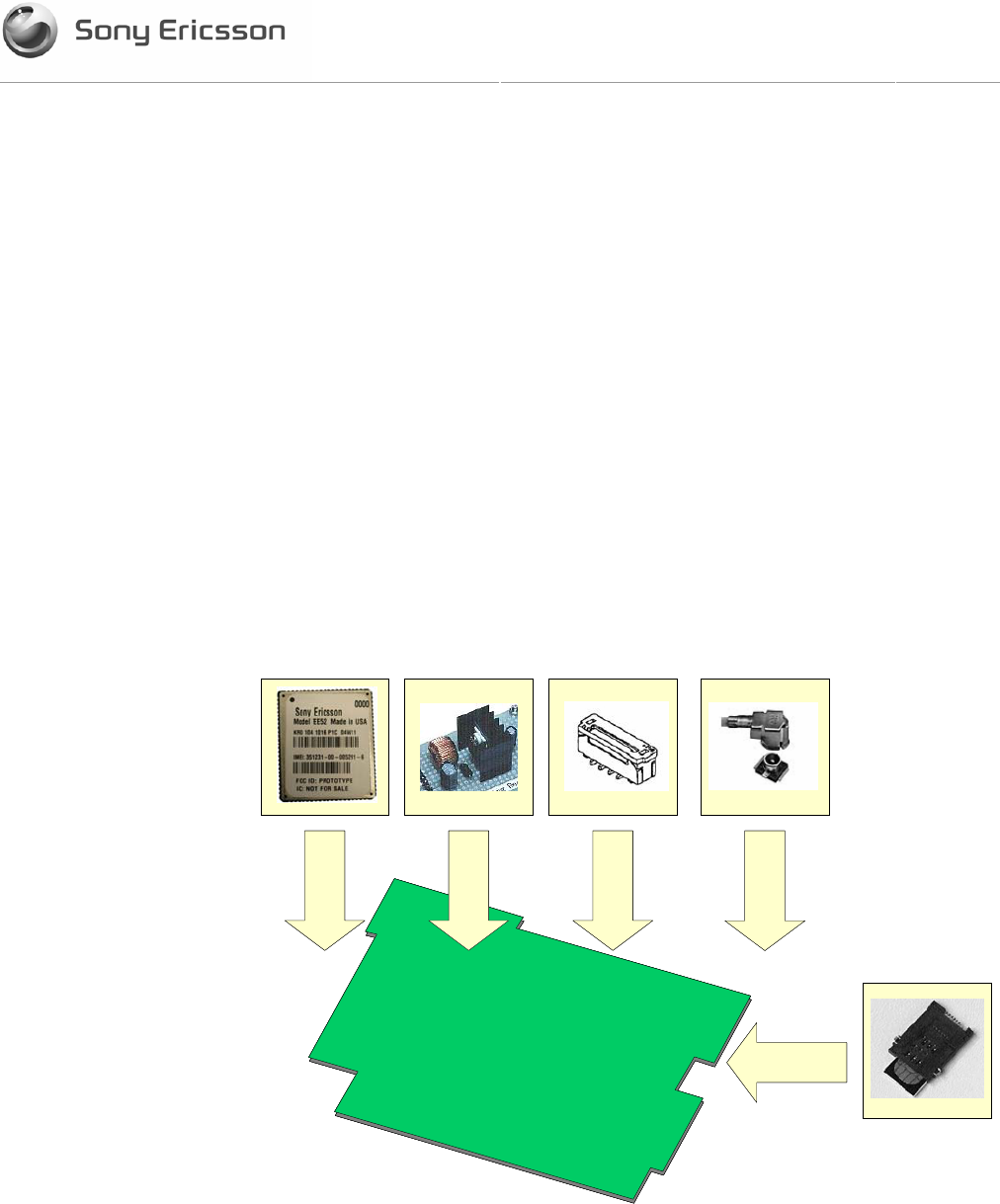
Confidential
INTERFACE DESCRIPT
5(31)
Document number Revision
1/155 19-KRD 104 1025 Uen PA4
1 Introduction
The EDGE Daughter Card is a total solution designed as an add-in option for integrators
of the host product. The Daughter Card comprises of several component parts:
• EDGE wireless modem, which is the wireless enabling circuitry integrated on to the
Daughter Card PCB together with its mechanical RF shielding
• RF connector, which provides physical connectivity between the Daughter Card and
the antenna which is integrated in to the notebook mechanical housing
• Voltage regulation circuitry, which converts raw unregulated power from the host
battery to the core regulated voltage to the EDGE wireless components
• System connector, which provided the data, control, power and status interface
between the host and the wireless modem
• SIM connector, a combined connector and retention device for the users Subscriber
Identity Module (SIM) card
EDGE WIRELESS
CIRCUITRY
VOLTAGE
REGULATION
SYSTEM
CONNECTOR
RF ANTENNA
CONNECTOR
DAUGHTER
CARD
SIM
CONNECTOR
EDGE WIRELESS
CIRCUITRY
VOLTAGE
REGULATION
SYSTEM
CONNECTOR
RF ANTENNA
CONNECTOR
DAUGHTER
CARD
SIM
CONNECTOR
Figure 1.1-1 EDGE Daughter Card Component Parts

Confidential
INTERFACE DESCRIPT
6(31)
Document number Revision
1/155 19-KRD 104 1025 Uen PA4
1.1 Target Users
1.2 Prerequisites
Integration of the EE5x Daughter Card may be performed at facilities under customer
management.
1.3 Notation
EDGE (Enhanced Data rate for GSM Evolution) is the wireless-enabling technology.
The EDGE Daughter Card describes the deliverable product. The EDGE Daughter Card
is a PCB assembly with the components described on the previous page integrated on to
the board. The complete assembly is reffered in this document as the DC (DC=Daughter
Card ).

Confidential
INTERFACE DESCRIPT
7(31)
Document number Revision
1/155 19-KRD 104 1025 Uen PA4
2 EDGE Wireless Modem
2.1 EDGE Wireless Modem in a Communication System
Figure 2.1-1 illustrates the main blocks of a wireless communication system using the
EDGE Daughter Card embedded in a host device. It also shows the communication
principles of the system. The definitions in the figure, as used elsewhere in this manual,
are in accordance with the recommendations of GSM 07.07.
• The MS (mobile station) represents the EDGE Daughter Card modem plus SIM card.
• The modem excluding SIM card, is known as the ME (mobile equipment).
• The TE (terminal equipment) is a micro-controller (i.e., the host) and is a part of the
application.
Figure 2.1-1 Main Blocks in a Wireless System
In accordance with the recommendations of ITU-T (International Telecommunication
Union - Telecommunications Standardisation Sector) V.24, the TE communicates with the
MS over a serial interface. This is the Universal Serial Bus (USB).
The functions of the EDGE modem follow the recommendations provided by ETSI
(European Telecommunications Standards Institute) and ITU-T.
ETSI specifies a set of AT commands for controlling the GSM/E-GSM element of the
modem; these commands are supplemented by Sony Ericsson specific commands.
Figure 2.1-2 Interface between Daughter Card and Application illustrates the interface
between the Daughter Card and the host application. Each interface signal is described in
Section 3.
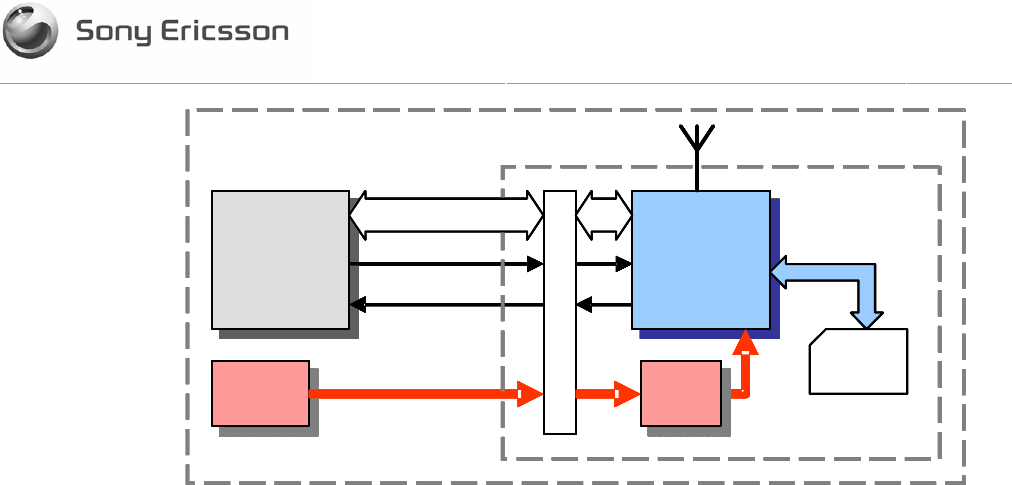
Confidential
INTERFACE DESCRIPT
8(31)
Document number Revision
1/155 19-KRD 104 1025 Uen PA4
TE
(DTE)
MS
(EDGE
MODEM)
SIM
Power
Power
SYSTEM CONNECTOR
Voltage
Reg
Voltage
Reg
Control
Status
Antenna
Communication
HOST EQUIPMENT
TE
(DTE)
MS
(EDGE
MODEM)
SIM
Power
Power
SYSTEM CONNECTOR
Voltage
Reg
Voltage
Reg
Control
Status
Antenna
Communication
HOST
TE
(DTE)
MS
(EDGE
MODEM)
SIM
Power
Power
SYSTEM CONNECTOR
Voltage
Reg
Voltage
Reg
Control
Status
Antenna
Communication
HOST EQUIPMENT
TE
(DTE)
MS
(EDGE
MODEM)
SIM
Power
Power
SYSTEM CONNECTOR
Voltage
Reg
Voltage
Reg
Control
Status
Antenna
Communication
HOST
Figure 2.1-2 Interface between Daughter Card and Application
Note that ITU-T standards define TE and TA as DTE (Data Terminal Equipment) and DCE
(Data Circuit Terminating Equipment) respectively.
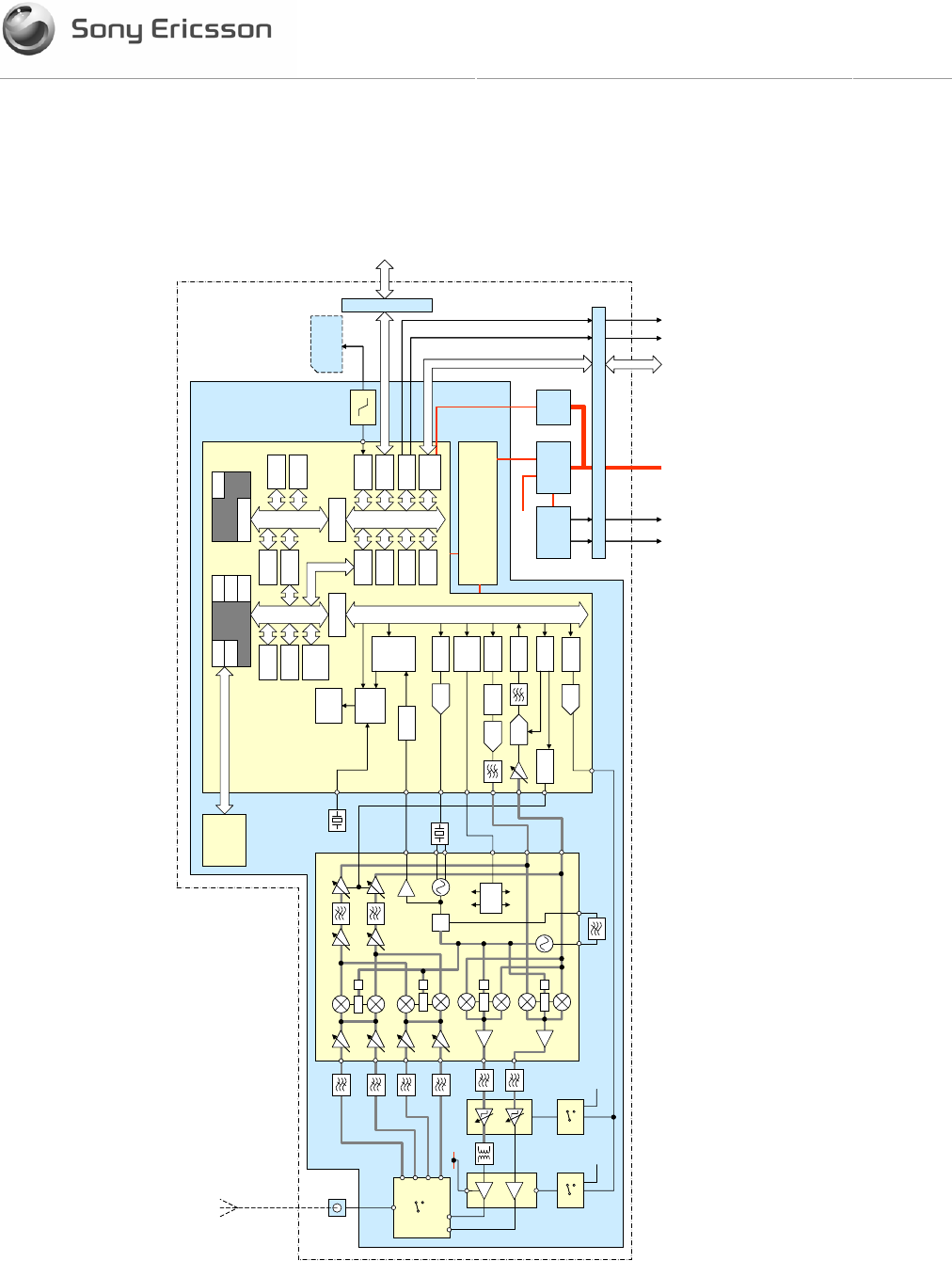
Confidential
INTERFACE DESCRIPT
9(31)
Document number Revision
1/155 19-KRD 104 1025 Uen PA4
2.2 Functional Block Diagram
A function representation of the EDGE duaghter card is included in the figure below.
Figure 2.2-1 EDGE Daughter Card Functional Block Diagram
CACHE
Arbiter
DMA
Bridge
JTAG
Interrupt
Control
Boot
ROM
Shared
Memory
External
Memory
Power
Mngmt
Channel
Coding
Bridge
XRAM
DROM
YRAM
PROM
PRAM
ARM926EJTeakLite
DSP
Interrupt
Control
A5
Encrypt
Equalizer
Viterbi
Accel
Power
Control
TX/RX
State
Machine
GSM
Timer
RF
Serial
Port
Burst
Buffer
AGC
Register
AGC
DAC
32kHz
XTAL
13MHz
VCXO
PROCESSOR BUS
90° :4
:4
:2
PLL
Burst
Buffer
AFC
Register
PGA
D-S
ADC
Mod
MOD
DAC
AFC
DAC
90°
90°
90° :2
PA
DAC
PA
RAM
SIM
USB
GPIO
MEMORY
VOLTAGE REGULATORS
OV &
SCCT
PROTECTION
SYSTEM CONNECTOR
POWER USB LED
VPA
SIM INTERFACE
LEVEL
SHIFTER
POWER STATUS
LOOP FILTER
RX SAW
FILTERS
bias
PA limiter
BALUN
DRIVER
SWITCH
fixed VAPC
VPA
ANT SWITCH
BASEBAND ASIC
RF TRANSCEIVER ASIC
ANTENNA
CONNECTOR
EDGE MODULE
DAUGHTER CARD
UART UART
TEST INTERFACE
PLL
fixed VAPC
SWITCHING
REGULATOR
VOLT
REG
Serial
Control
RI
CACHE
Arbiter
DMA
Bridge
JTAG
Interrupt
Control
Boot
ROM
Shared
Memory
External
Memory
Power
Mngmt
Channel
Coding
Bridge
XRAM
DROM
YRAM
PROM
PRAM
ARM926EJTeakLite
DSP
Interrupt
Control
A5
Encrypt
Equalizer
Viterbi
Accel
Power
Control
TX/RX
State
Machine
GSM
Timer
RF
Serial
Port
Burst
Buffer
AGC
Register
AGC
DAC
32kHz
XTAL
13MHz
VCXO
PROCESSOR BUS
90° :4
:4
:2
PLL
Burst
Buffer
AFC
Register
PGA
D-S
ADC
D-S
ADC
Mod
MOD
DAC
MOD
DAC
AFC
DAC
AFC
DAC
90°
90°
90° :2
PA
DAC
PA
DAC
PA
RAM
SIM
USB
GPIO
MEMORY
VOLTAGE REGULATORS
OV &
SCCT
PROTECTION
SYSTEM CONNECTOR
POWER USB LED
VPA
SIM INTERFACE
LEVEL
SHIFTER
POWER STATUS
LOOP FILTER
RX SAW
FILTERS
bias
PA limiter
BALUN
DRIVER
SWITCH
fixed VAPC
VPA
ANT SWITCH
BASEBAND ASIC
RF TRANSCEIVER ASIC
ANTENNA
CONNECTOR
EDGE MODULE
DAUGHTER CARD
UART UART
TEST INTERFACE
PLL
fixed VAPC
SWITCHING
REGULATOR
VOLT
REG
Serial
Control
RI

Confidential
INTERFACE DESCRIPT
10(31)
Document number Revision
1/155 19-KRD 104 1025 Uen PA4
2.3 Features
The EDGE modem performs a set of telecom services (TS) according to GSM standard
phase 2+, ETSI and ITU-T. The functions of the modem are implemented by issuing AT
commands over a serial interface.
2.3.1 Mobile Station Characteristics
The EDGE modem can be configured for single, dual, triple and quad band GSM
functionality. The quad band characteristics of the EDGE modem are shown in the
following table.
EDGE MODEM GSM850 E-GSM900 GSM1800 GSM1900
Frequency range (MHz) TX: 824-849
RX: 869-894
TX: 880-915
RX: 925-960
TX: 1710-1785
RX: 1805-1880
TX: 1850-1910
RX: 1930-1990
Channel spacing 200kHz
Number of channels 123 x 8 (TDMA) 173 x 8 (TDMA) 373 x 8 (TDMA) 298 x 8 (TDMA)
Duplex spacing 45MHz 95MHz 80MHz
GSM/GPRS GMSK
Modulation EDGE 8-PSK
Nom. TBD
Tx phase accuracy
(burst) Max. <5° rms phase error ; <20° max peak phase error
100KHz <+0.5dB
200KHz <-30dB
250KHz <-33dB
Tx Spectrum Due to
Modulation
400KHz <-58dB
100KHz <-23dBm
200KHz <-26dBm
250KHz <-32dBm
Tx Spectrum Due to
Switching Transients
400KHz <-36dBm
Receiver sensitivity (ANT pin) <-102dBm <-102dBm <-102dBm <-102dBm
Class Class 4 Class 1
GSM Nom. +33dBm +30dBm
Class Class E2 Class E2
Transmitter
output power
(ANT conn) EDGE Nom. +27dBm +26dBm
Nom.1 <-104dBm <-104dBm <-104dBm <-104dBm Receiver sensitivity
(ANT connector) Max. <-102dBm <-102dBm <-102dBm <-102dBm
f1 -49dBm
Rx Intermodulation
F0 = 2f1-f2;
|f2–f1| = 800KHz f2 -49dBm
GPRS operation Class 10
1 - Design aim
Note that the number of frequency bands available will be dependant upon the factory
configuration.
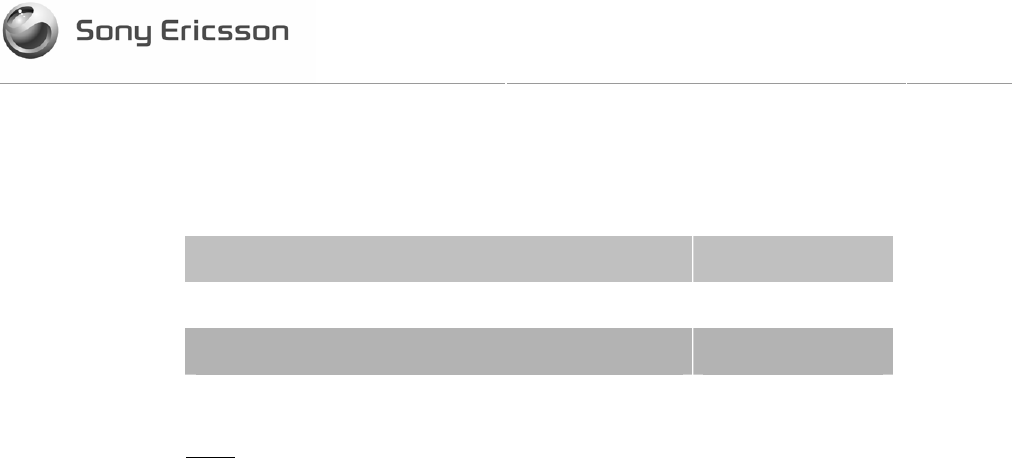
Confidential
INTERFACE DESCRIPT
11(31)
Document number Revision
1/155 19-KRD 104 1025 Uen PA4
2.3.2 Environmental Conditions
The DC will support the following environmental conditions
Temperature Range (Full GSM Specification)1 -10oC to +55oC
Temperature Range (Operational) 2 -20oC to +65oC
Storage Temperature Range -20°C to +75°C
Table 2.3-1 Environmental Conditions
Notes
1. Full compliance to Type Approval and Regulatory Approval requirements between these
temperature ranges
2. Design Verification Testing (DVT) and Operational compliance between these temperature
ranges.
2.4 SIM Card
An external SIM card with 3V or 1.8V technology, can be connected to the modem via the
SIM interface pins.
2.5 Other Features
The EDGE modem supports a number of additional features including
• 07.10 multiplexing (normal mode)
• SIM application tool kit
2.6 Precautions
The EDGE modem device is ESD protected up to 4K V contact and 8K V air discharge. It
is recommended that integrators follow electronic device handling precautions when
working with any electronic device system to ensure no damage occurs to the host or the
radio device.
The EDGE modem is integrated on to the daughter card. When the card is mounted in
the host it is the responsibility of the integrator to ensure that static discharge protection
beyond the voltages specified above are designed in to the host product. If exposed, the
antenna is a vulnerable contact point for ESD.

Confidential
INTERFACE DESCRIPT
12(31)
Document number Revision
1/155 19-KRD 104 1025 Uen PA4
Part 2 : Daughter Card Description
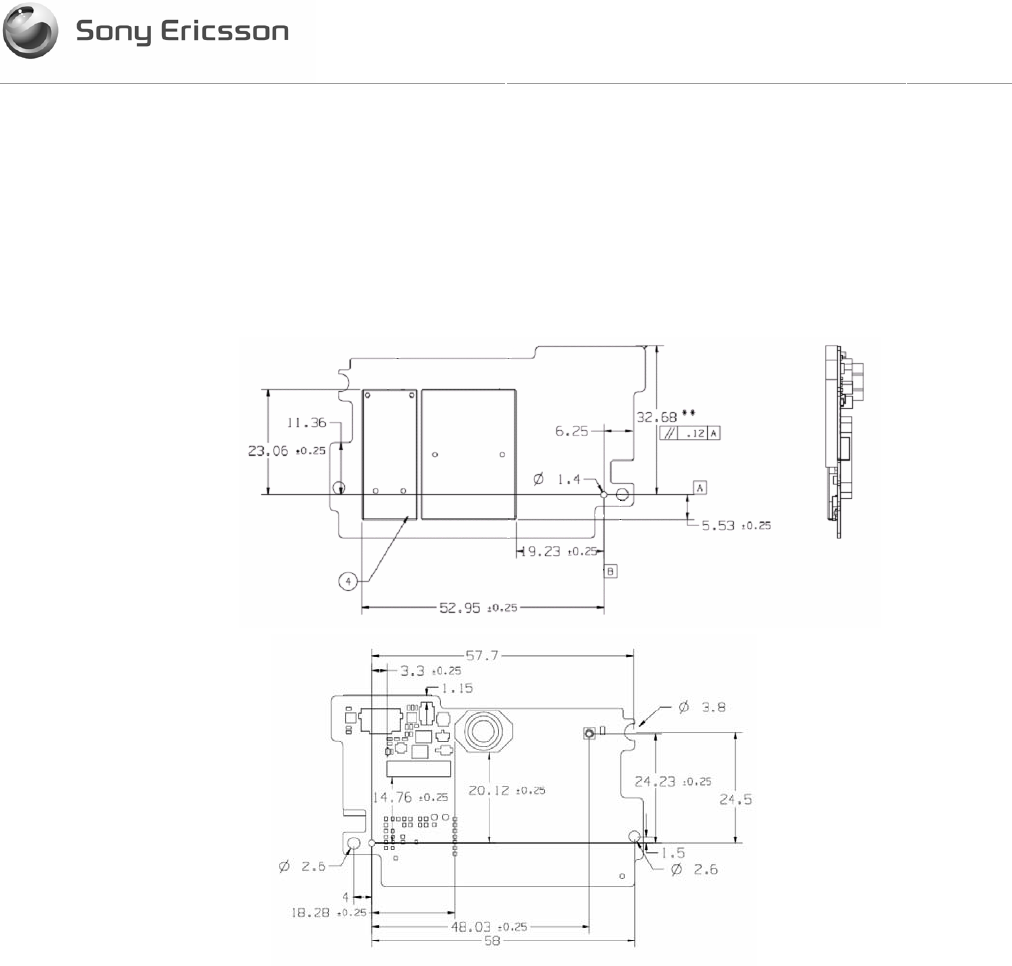
Confidential
INTERFACE DESCRIPT
13(31)
Document number Revision
1/155 19-KRD 104 1025 Uen PA4
3 Mechanical Description
3.1 Physical Detail
Dimensional details given here are for reference only. For mechanical design data,
please refer to the mechanical outline drawings.
Figure 3.1-1 Layout Detail (reference only)
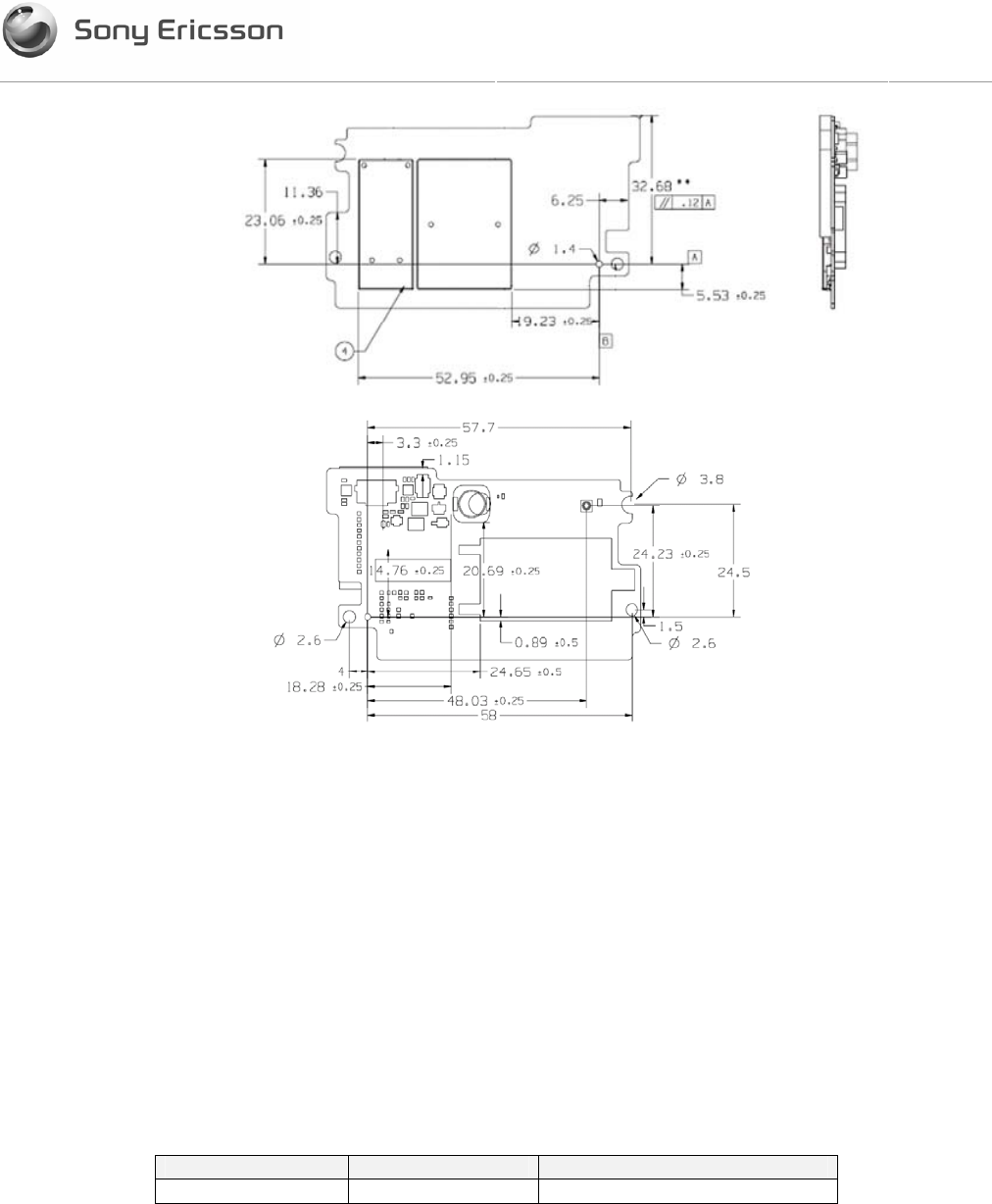
Confidential
INTERFACE DESCRIPT
14(31)
Document number Revision
1/155 19-KRD 104 1025 Uen PA4
Figure 3.1-2 Layout Detail – Reservoir capacitor version (reference only)
3.2 Variant Information
As evident from the preceding section, there is more than one version of the Daughter Card.
The “/3” version notably differs from the “/2” version by the type of system connector and
board mounting hole locations. This section will describe in detail the differences between
the variants.
3.2.1 Board Outline
The board outline differences have been made to accommodate the reservoir capacitor.
3.2.2 System Connector
The system connector mounted on the various versions is summarized in the following
table. Additional information on the system connector can be found in section 4.1.1
Variant P/N Connector Type Connector Lead Free Status
TBD Vertical mount Lead Free
Note: The lead-free status should be considered when selecting the mating FFC/FPC.
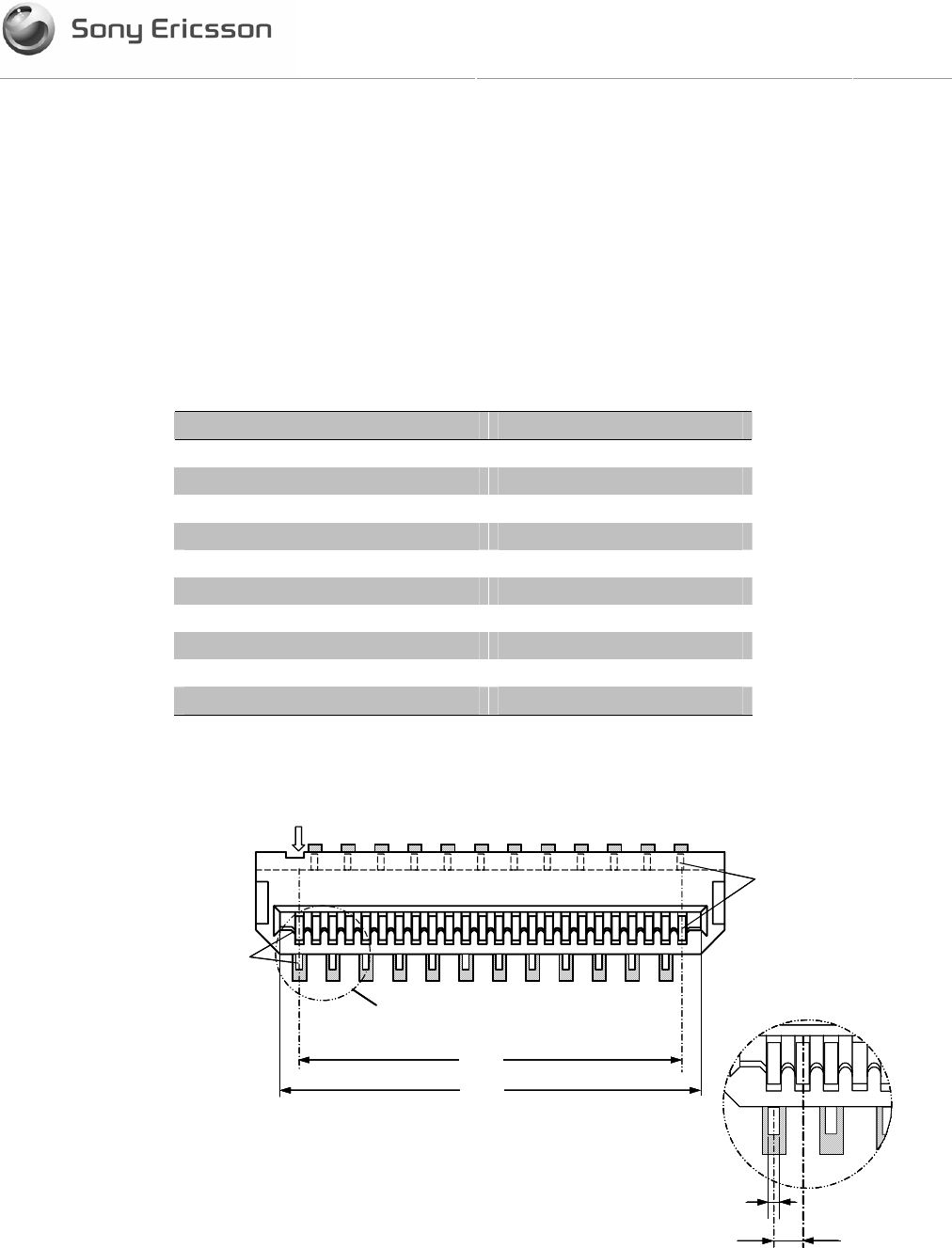
Confidential
INTERFACE DESCRIPT
15(31)
Document number Revision
1/155 19-KRD 104 1025 Uen PA4
4 System Interface
4.1 Overview
4.1.1 System Connector
All of the systems interface signals flow through a single connector; power, ground, data,
cotrol, status and GPIO.
Electrical connections to the modem are made through a 24 pin low insertion force (LIF)
vertical SMT mount FFC or FPC cable receptor. The connector is a single sided contact
type, for example the AVX Elco part 04-6244-024-011-800.
Connector type NON-ZIF (LIF) ST SMT
Contact Single
Profile Height (mm) 4.10
Number of Contacts 24
Current Rating 0.4A Max.
Voltage Rating 50V Max.
Dielectric withstanding voltage 200Vrms
Contact Material Phosphor bronze Tin-Plated*
Insulator material Heat resistant plastic
Operating temperature 40ºC~+85ºC
FFC/FPC thickness 0.3±0.05
* Tin-Lead plated on non Pb-free version
Table 4.1-1 Connector Characteristics
DATUM MARK
(DATUM PIN)
DETAIL A
PIN 1
PIN 24
DETAIL A
0.2 ±0.05
0.5 TYP
11.5
12.6
DATUM MARK
(DATUM PIN)
DETAIL A
PIN 1
PIN 24
DETAIL A
0.2 ±0.05
0.5 TYP
11.5
12.6
Figure 4.1-1 Vertical Connector Detail
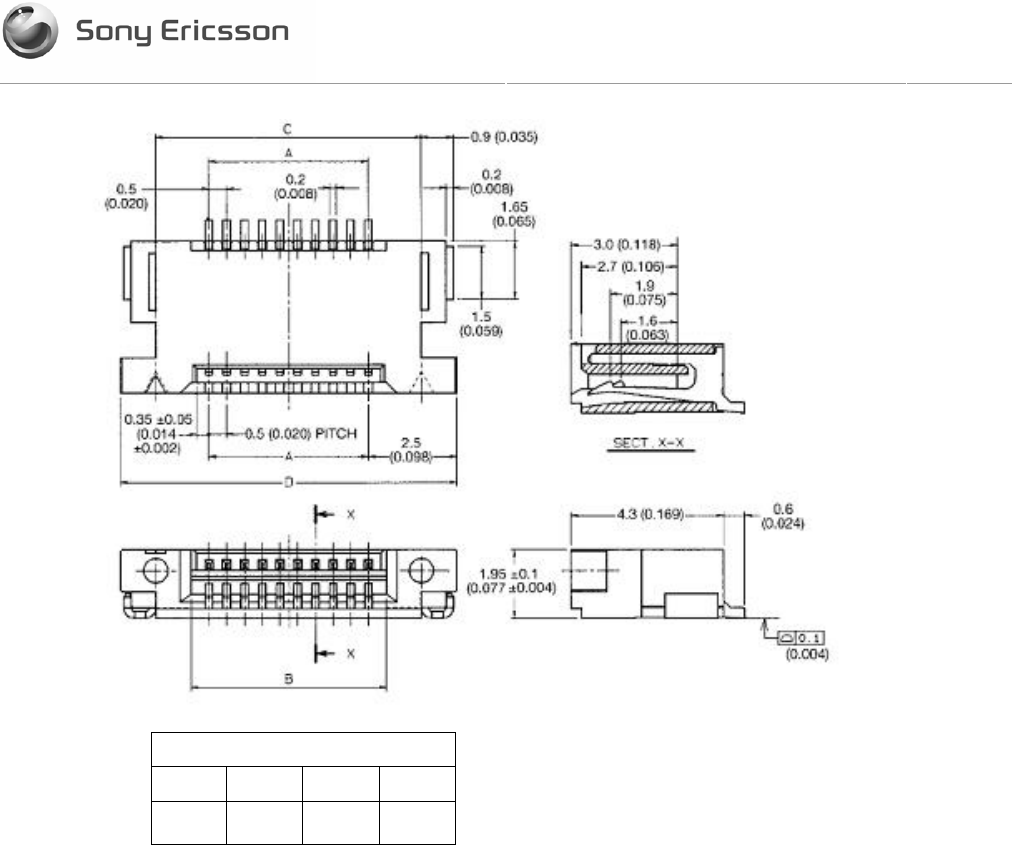
Confidential
INTERFACE DESCRIPT
16(31)
Document number Revision
1/155 19-KRD 104 1025 Uen PA4
Dimension
A B C D
11.5
(0.453)
12.5
(0.492)
14.5
(0.571)
16.5
(0.650)
Figure 4-2 Right Angle Connector Detail
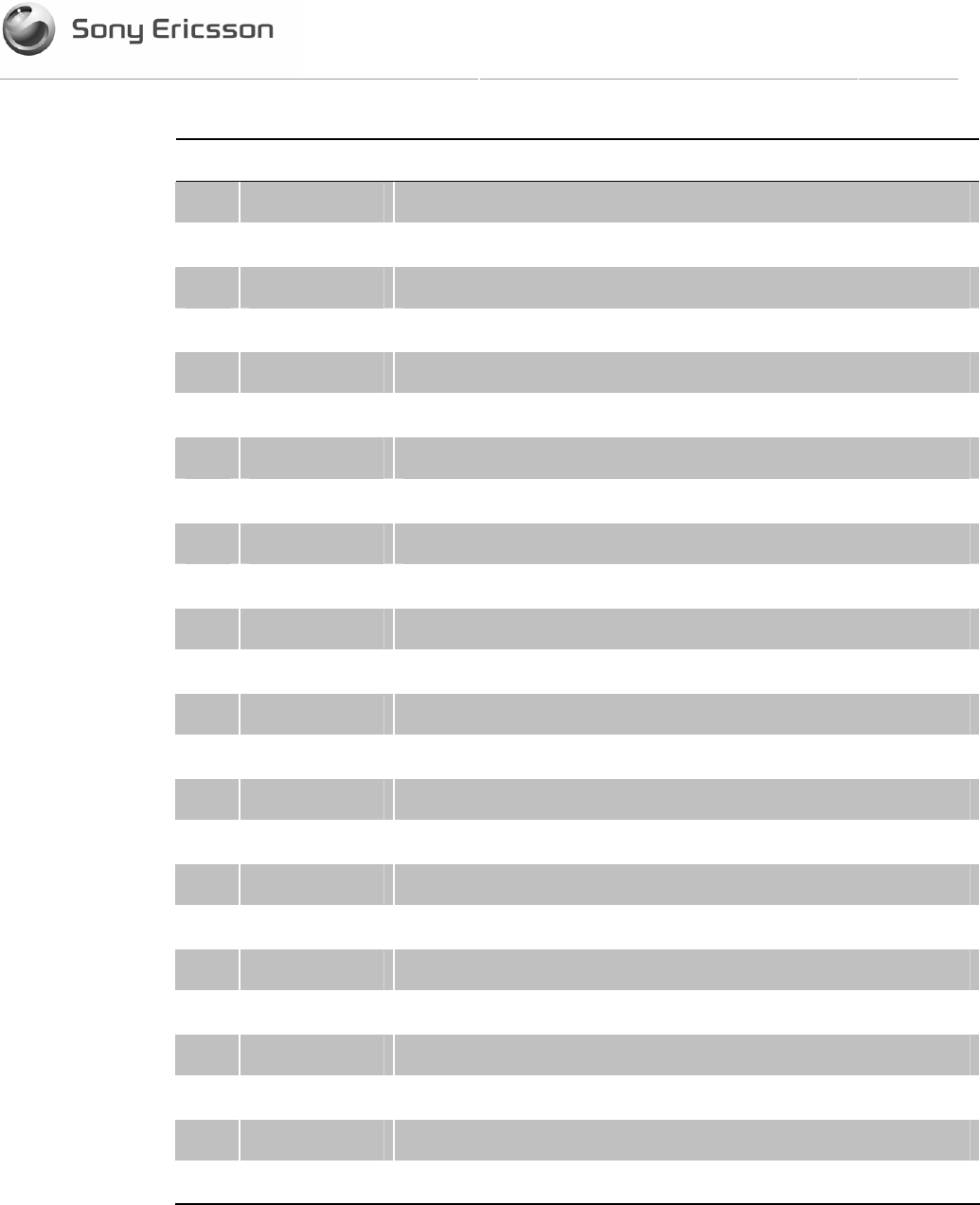
Confidential
INTERFACE DESCRIPT
17(31)
Document number Revision
1/155 19-KRD 104 1025 Uen PA4
Pin Name Function
1 USB_DN USB differential (-) line
2 USB_DP USB differential (+) line
3 VREF Modem logic voltage reference output from daughter card
4 OVP Over voltage protection output from daughter card
5 SPARE
6 SPARE
7 SPARE
8 GND Ground
9 GND Ground
10 GND Ground
11 GND Ground
12 GND Ground
13 GND Ground
14 VIN Voltage input from host application
15 VIN Voltage input from host application
16 VIN Voltage input from host application
17 VIN Voltage input from host application
18 VIN Voltage input from host application
19 VIN Voltage input from host application
20 RI Ring Indicator output from daughter card
21 3V3 Application reference voltage input to daughter card
22 LED Pulsing LED output from daughter card
23 UVP Under voltage & short circuit protection output from daughter card
24 P_EN Power ON enable input to daughter card
Table 4.1-2 Pin List

Confidential
INTERFACE DESCRIPT
18(31)
Document number Revision
1/155 19-KRD 104 1025 Uen PA4
4.2 Electrical Interface Detail Format
Details of each electrical interface is contained in paragraph 5 (beginning page 19). The
description of each interface follows a common format. An example is shown below:
Interface Name
This is the name of the interface; usually this is the actual name found in the pin list;
sometimes this is a collective name for a number of signals, such as the example
shown here for a UART.
Function:
This identifies the basic function of the interface; some interfaces are grouped
according to their functional sub-class.
Description:
The description contains a basic overview of the interface and its functional
relationship with the host.
Pin Numbers:
All pin numbers associated with the interface are listed; these will not necessarily
be in numerical order but may be arranged to coincide with signal name list.
Signal Names:
All sigal names associated with the interface exactly as shown in the pin list; the
signal names also contain information on signal flow direction.
If not used:
This gives specific details, for each signal, of how to terminate the physical
connection if it is not required by the host; failure to observe this convention may
result in unstable operation of the EDGE modem. (This may not be necessary in the
host application since all signals have a defined function).

Confidential
INTERFACE DESCRIPT
19(31)
Document number Revision
1/155 19-KRD 104 1025 Uen PA4
5 Electrical Interface
This section describes each signal line of the electrical interface between the EDGE
modem and the host application. A summary of the function of each signal is provided,
together with any additional relevant information.
Signals are described from the perspective of the EDGE modem and Daughter Card
circuitry. Consequently signals described as input are inputs to the modem, driven by the
host [host⇒modem]. Likewise, signals described as output are driven by the modem in to
the host [modem⇒host]. Bi-directional signal flow (I/O) is indicated by a double-headed
arrow [modem⇔host]. In some instances the [daughter card] will be identified if the
modem circuitry is not directly involved, or where additional interface circuitry resides
between the host and the modem.
Signals which are pulled internally are identified in parentheses beside the signal name as
either (PU)=Pulled Up or (PD)=Pulled Down. Signals with no designation are not pulled
either way.
5.1 Power Interfaces
This section describes the power, ground, and other signals that control or indicate power
states.
• VIN
• 3V3
• VREF
• GND

Confidential
INTERFACE DESCRIPT
20(31)
Document number Revision
1/155 19-KRD 104 1025 Uen PA4
Note: Any hard copy of this document is for reference only. Due to template and application dependencies the header and footer may fail to display correct data. It is
the responsibility of the user to ensure that they have a correct and valid version. Any outdated hard copy is invalid and must be removed from possible use.
5.1.1 VIN
Function: Daughter card power supply
Description: Primary voltage supply to switching regulator
Pin Numbers: 14, 15, 16, 17, 18, 19
Signal Names: VIN [host⇒daughter card]
If not used: Required
Details:
Power provided by the host will range from 5.5V minimum to a maximum 20.0V. The
Daughter Card has on board regulation which regulates the supply range to a steady 3.6V
by means of a switching regulator rated at 3A max. The supply voltage range for the
monitor mount version, which includes the reservoir capacitor is 4.8V minimum to a
maximum of 20.0V.
Typical Electrical Characteristics:
Parameter Condition Low Mid High Unit
Voltage Min1 7.4 20.0 V
Peak2
w/o reservoir
capacitor
GSM850
2-slot TX
1880 1500 <1000
Peak2
with reservoir
capacitor
GSM850
2-slot TX
<1000 <1000 <1000
Transmit mode
Power Consumption
(worst case)
average GSM850
2-slot TX
450 340 145 est
mA
Idle mode
Power Consumption
(worst case)
average DRX 2 9.9 7.6 3.8 est mA
1. Min voltage for /2 and /21 variant is 5.5 V. Min voltage for /3 variant is 4.8 V.
2. Peak current consumption is an instantaneous value which occurs during a TDMA
transmitter burst.
Table 5.1-1: VIN Electrical Characteristics

Confidential
INTERFACE DESCRIPT
21(31)
Document number Revision
1/155 19-KRD 104 1025 Uen PA4
5.1.2 3V3
Function: Daughter card reference voltage
Description: Host reference to protection circuit & USB (3.3V)
Pin Numbers: 21
Signal Names: 3V3 [host⇒daughter card]
If not used: Required
Details:
The host supplies a 3.3V regulated supply to the Daughter Card for two primary functions
:
• reference supply for the undervoltage / short circuit protection circuitry
• input for the USB interface
Electrical Characteristics:
Parameter Condition Min Nom Max Unit
Voltage 3.30 V
Ripple 100 mV
5.1.3 VREF
Function: Voltage Reference
Description: Core digital voltage reference from modem.
Pin Number: 3
Signal Name: VREF [modem⇒host]
If not used: Required
Details:
VREF is supplied as a reference voltage from the modem. This reference is the modem’s
core digital supply voltage at a nominal 2.80V.
The interface is capable of sourcing 200uA and is intended primarily for situations where
host interface circuitry is required to be level shifted to maintain wireless modem signal
level compatibility. If more current is required by the host, a current amplifier must be
implemented.

Confidential
INTERFACE DESCRIPT
22(31)
Document number Revision
1/155 19-KRD 104 1025 Uen PA4
This signal can also be used to indicate whether the wireless modem is powered on or
not. A high level (2.7V to 2.9V) indicates that the modem is powered on. A low level
(<0.5V) indicates that the modem is powered off.
All digital logic, except the SIM interface, is characteristic CMOS logic operating at VREF.
Electrical Characteristics:
Parameter Condition Min Typ Max Unit
inactive 0.3 0.5 V
VREF output voltage active 2.70 2.80 2.90 V
VREF output current IOUT 200 uA
Table 5.1-2: VREF Electrical Characteristics
5.1.4 GND
Function: Ground
Description: Modem common rail
Pin Numbers: 8, 9, 10, 11, 12, 13
Signal Name: GND
If not used: Required
Details:
Return path for all currents.

Confidential
INTERFACE DESCRIPT
23(31)
Document number Revision
1/155 19-KRD 104 1025 Uen PA4
5.2 Status Interfaces
Status interfaces indicate or control status features of the modem.
• UVP
• OVP
• RI
• LED
• VREF
5.2.1 UVP
Function: Under voltage protection
Description: Status indicator to host of potential malfunction in Daughter Card
circuitry
Pin Number: 23
Signal Name: UVP (PD) [daughter card⇒host]
If not used: Required
Details:
The Daughter Card has FET circuitry which uses 3V3 as a reference, driving an output to
the host indicating the voltage condition of the of VBAT (the modem supply voltage). A
resistive divider connected to VBATT presents a very low Vbe to the UVP transistor. This
presents a steady state low voltage output under normal VBAT conditions with external
pulldown circuitry. In the event of a short circuit or high current fault condition on the
Daughter Card, the voltage drop from the switching regulator will bias the UVP transistor
on and present a high output to the host monitoring circuit.
The UVP signal should be pulled low by the application circuit for correct function.
Electrical Characteristics:
Parameter Condition Min Typ Max Unit
Normal 0.5 V
UVP output voltage Fault 3.3 V
Table 5.2-1: UVP Electrical Characteristics

Confidential
INTERFACE DESCRIPT
24(31)
Document number Revision
1/155 19-KRD 104 1025 Uen PA4
5.2.2 OVP
Function: Over voltage protection
Description: Status indicator to host of potential malfunction in Daughter Card
circuitry
Pin Number: 4
Signal Name: OVP (PU) [daughter card⇒host]
If not used: Required
Details:
The OVP signal is simply an output from the main onboard regulator. In it’s operational
state under normal functional conditions this will output 3.6V nominal
Parameter Condition Min Typ Max Unit
Normal 3.6 V
UVP output voltage Fault 3.7 V
Table 5.2-2: OVP Electrical Characteristics
5.2.3 RI
Function: Ring Indicator
Description: Alert signal from the modem to indicate an incoming SMS, or
unmasked unsolicited response
Pin Number: 20
Signal Name: RI [modem⇒host]
If not used: Leave open
Details:
Ring Indicator is essentially a wake-up call from the modem to the host application to
signal one of two events:
• an in-coming message (SMS).
• an unmasked unsolicited response/result code.
For the EDGE modem the Ring Indicator is implemented as a GPIO interface within the
EDGE baseband device.

Confidential
INTERFACE DESCRIPT
25(31)
Document number Revision
1/155 19-KRD 104 1025 Uen PA4
A falling edge indicates an alert or message. The signal remains low for a period of time
before going high. An SMS-page or unsolicited response/result code generates one pulse
(the length is configurable using an AT command)[TBC].
The ring indicator is implemented on the daughter card as an open collector transistor
output to allow the host the convenience of driving Viao circuitry.
5.2.4 LED
Function: LED
Description: LED-signal indicating a status change
Pin Number: 22
Signal Name: LED [modem⇒host]
If not used: Leave open
Details:
The LED is implemented on the Daughter Card as an open collector transistor output
which providesa driver level interface to an LED acting as a status indicator for the user.
The LED output can be made to blink at a rate pre-determined by modem software.
5.2.5 VREF
The function of VREF is already described in 5.1.3. This interface can be used as a
status indicator to the host that the modem is still powered. VREF is present whilst the
modem is powered and is removed upon the completion of the modem power down. This
feature can be useful in the event of a communications lock-up between the host and the
daughter card.

Confidential
INTERFACE DESCRIPT
26(31)
Document number Revision
1/155 19-KRD 104 1025 Uen PA4
5.3 Data Communication and Control Interfaces
The serial data and control interfaces consist of the following :
• USB
• P_EN
5.3.1 USB Interface
Function: USB data communication port
Description: USB transmit and receive port for data communication between
modem and host.
Pin Numbers: 1, 2
Signal Names: USB_DP (2) [modem⇔host]
USB_DN (1) [modem⇔host]
If not used: Required
Details:
The USB interface is designed to USB 1.1 specifications. Details of the specific function
of the USB interface can be found in section 6.3.
Power to the USB interface is provided by the 3V3 input from the host.
5.3.2 P_EN
Function: Power Enable
Description: Modem power enable control from host
Pin Numbers: 24
Signal Names: P_EN [host⇒daughter card]
If not used: Required
Details:
The power enable signal is provided from the host application and is routed to the
switching regulator shutdown input and also to the REG_EN (regulator enable) pin on the
modem. Assertion of this pin will initiate power up. The P_EN pin is active high and has
to be maintained continually in order to keep the modem powered.
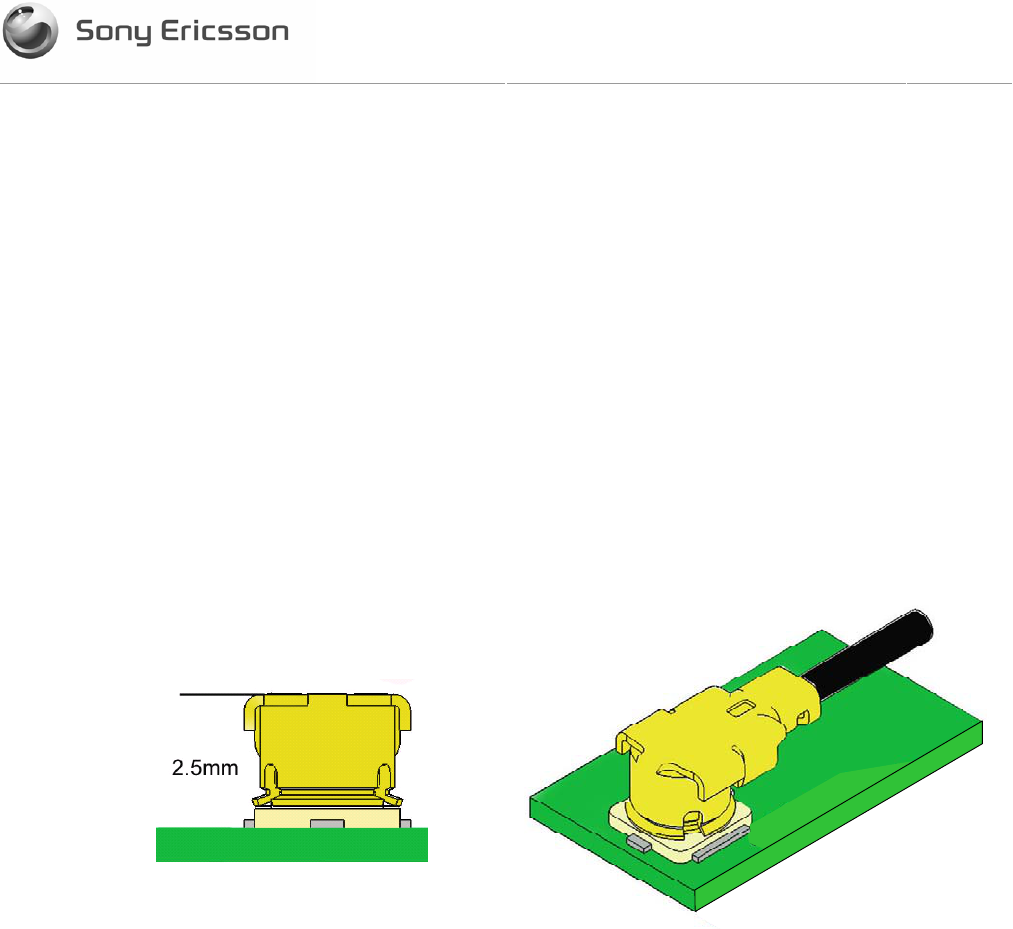
Confidential
INTERFACE DESCRIPT
27(31)
Document number Revision
1/155 19-KRD 104 1025 Uen PA4
5.4 ANTENNA CONNECTOR
Function: Antenna connector
Description: 50 ohm wireless antenna connection.
Pin Numbers: N/A
Signal Names: ANTENNA
If not used: Required
Details:
The antenna interface to the modem is routed to a low profile coaxial connector on the
daughter card. The antenna connector has a nominal impedance of 50 ohms and a
maximum frequency rating of 2.5GHz. The connector type is MHF. Mated height is
2.5mm
IMPORTANT NOTE:
FCC Radiation Exposure Statement:
This equipment complies with FCC radiation exposure limits set forth for an uncontrolled
environment. This equipment should be installed and operated with minimum distance of
20cm between the radiator and your body.
This transmitter must not be co-located or operating in conjunction with any other antenna
or transmitter.
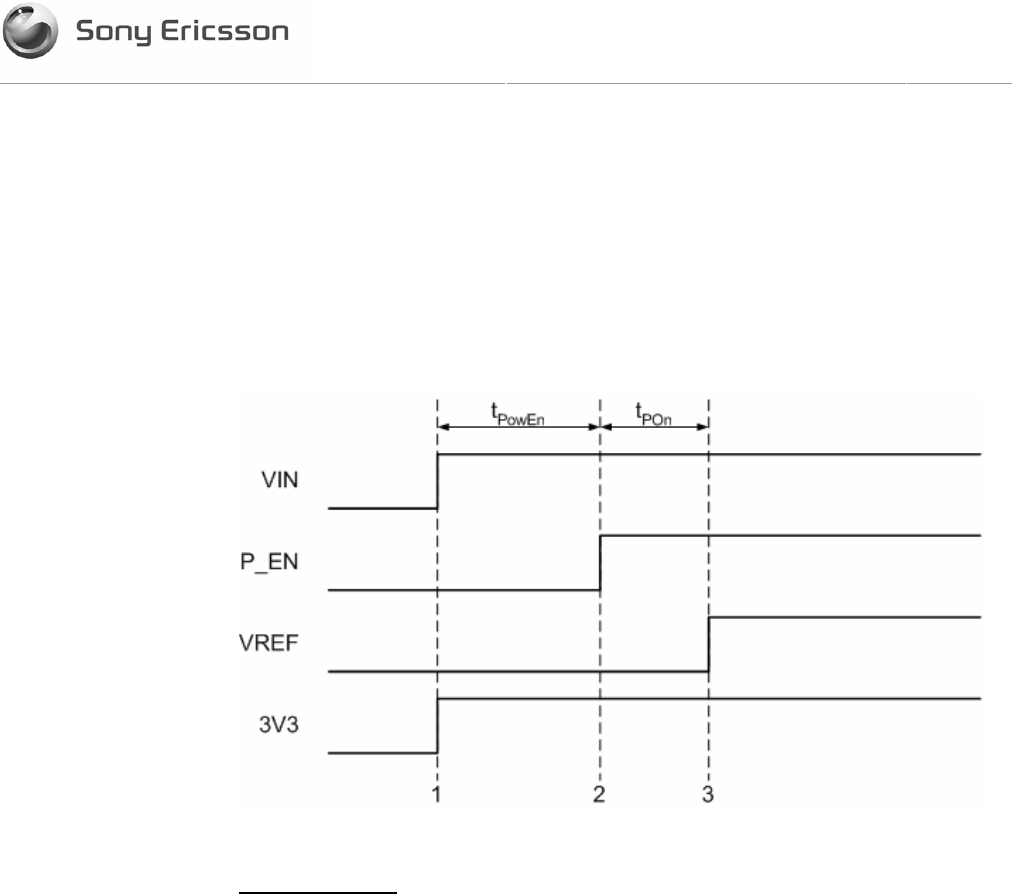
Confidential
INTERFACE DESCRIPT
28(31)
Document number Revision
1/155 19-KRD 104 1025 Uen PA4
6 Rudimentary Circuit Functions
This section contains some rudimentary circuit functions for the sequencing of powering
the modem up and down.
6.1 Power On Sequence
This sequence illustrates the power on procedure.
Figure 6.1-1 Power On Sequence
Sequence Detail:
1 VIN and 3V3 are supplied to the modem by the host. These two voltages can be
supplied simultaneously when the Daughter Card is required to be powered on.
Both voltages must be present before the power on sequence is initiated for the
Daughter Card to function correctly.
2 Once VIN and 3V3 voltages are applied the host can enable power up by
asserting power enable signal P_EN. The power up process will begin.
3 VREF may be used as an indicator that the modems regulators are powered.
tPOn is typically less than 70 ms
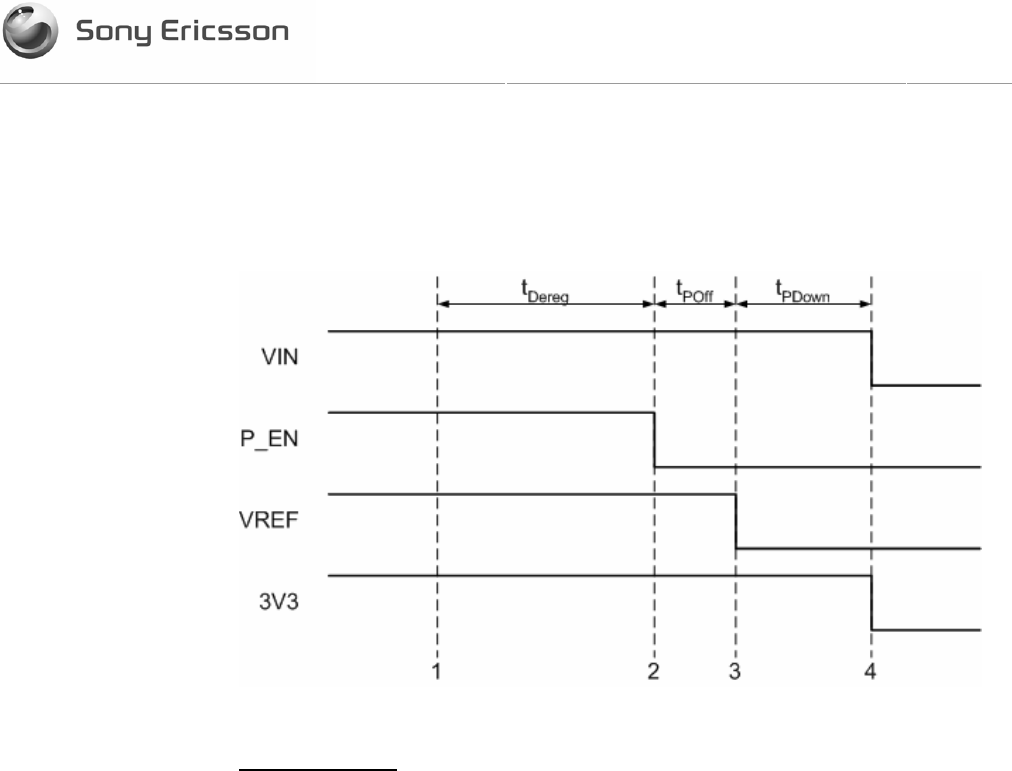
Confidential
INTERFACE DESCRIPT
29(31)
Document number Revision
1/155 19-KRD 104 1025 Uen PA4
6.2 Power Off Sequence
This sequence illustrates the power off procedure.
Figure 6.2-1 Power Off Sequence
Sequence Detail:
1 The “AT+CFUN=4” instruction is sent from the host application to the modem in
order to initiate a deregistration sequence.
2 The modem responds to the request with an ‘OK’ to indicate that deregistration
is completed. Deregistration from the network can take from 3-30 seconds.
After de-registration has been acknowledged the host application may remove
P_EN.
3 The switching regulator output capacitor will gradually discharge until the modem
regulators threshold is exceeded. and power down will be complete. VREF may
be used as indicator of complete shut down.
4 When the modem has successful shutdown, and VREF has fallen bellow 0.5V
then the host may safely remove VIN and 3V3 at any time. However the
supplies can remain active without increasing current consumption (typically
<25uA).
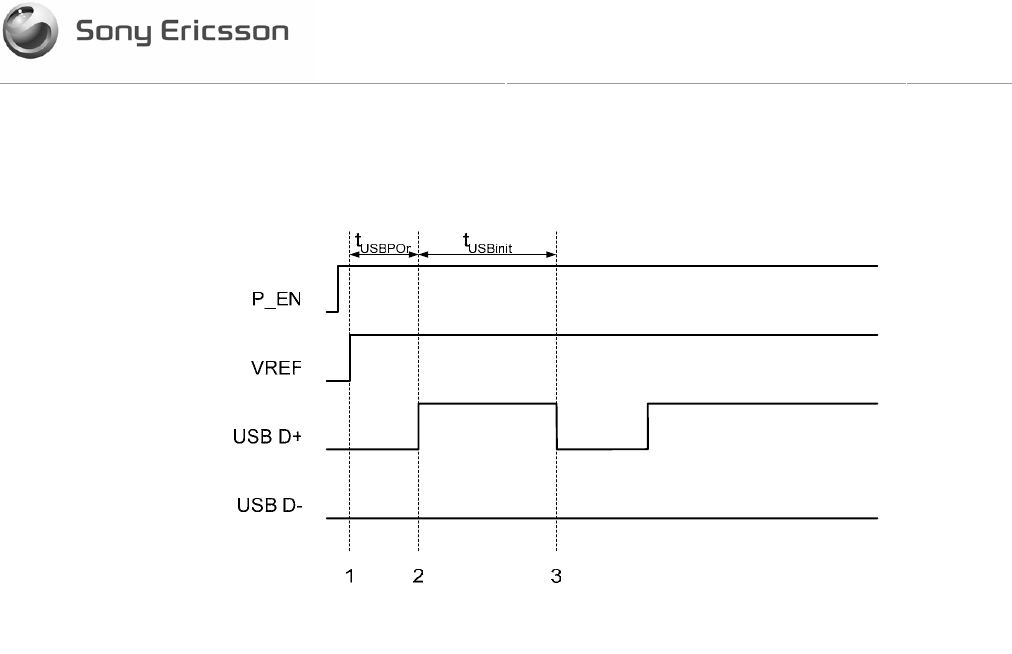
Confidential
INTERFACE DESCRIPT
30(31)
Document number Revision
1/155 19-KRD 104 1025 Uen PA4
6.3 USB communications information
This sequence illustrates USB initialization.
1. The startup sequence begins with the completion of the power up ramping of the
VREF signal as described in Power On Sequence.
2. The D+ signal is brought high with the power up of the USB block in the
baseband circuitry. This produces the J state indicating to the USB host that a
device is attaching.
3. A host initiated SE0 begins the USB protocol transactions.
USB enumeration information
Using the supplied drivers, the Daughter Card will be identified as a USB peripheral with
the following descriptor data:
Device Descriptor:
bcdUSB: 0x0110
bDeviceClass: 0x00
bDeviceSubClass: 0x00
bDeviceProtocol: 0x00
bMaxPacketSize0: 0x40 (64)
idVendor: 0x0FCE
idProduct: 0xD019
bcdDevice: 0x202
iManufacturer: 0x00
iProduct: 0x00
iSerialNumber: 0x00
bNumConfigurations: 0x01
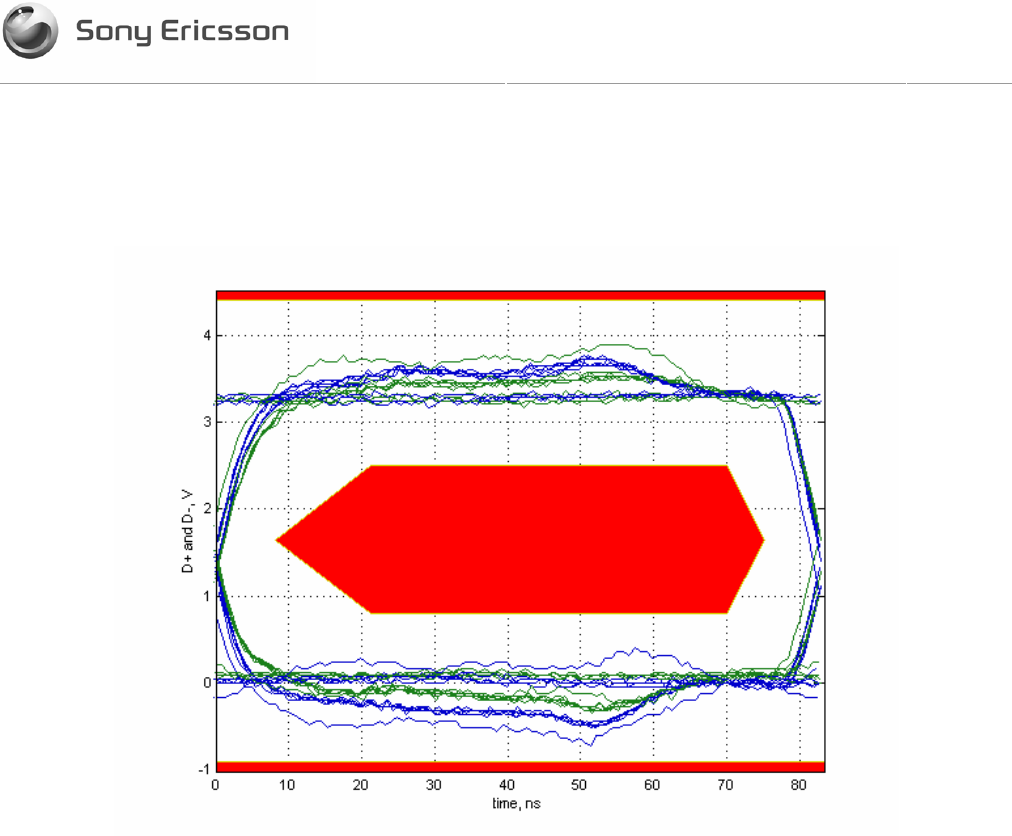
Confidential
INTERFACE DESCRIPT
31(31)
Document number Revision
1/155 19-KRD 104 1025 Uen PA4
Eye Diagram for Full Speed USB signaling.
The USB link runs at full-speed (12 Mbps). The following diagram is exhibited from
compliance testing data.